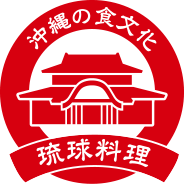We will introduce the culture associated with Ryukyu cuisine, as well as its recipes.

Court Cuisine
Ceremonial Cuisine
The Local People’s Cuisine
Ryukyu Sweets
Utwimuchi (Hospitality) and Court Cuisine
Developed Deeply Influenced by both China and Japan
For about 450 years from the year 1429, Okinawa was an independent country called the Ryukyu Kingdom. In the Ryukyu Kingdom, magnificent court cuisine was created for royal events, ceremonies, and entertainment. The development of court cuisine was greatly influenced by Ryukyu’s relationship with China, as seen by the visiting envoys from the 15th century onward, and furthermore by its relationship with Japan, which can be seen in the visiting magistrates from the Satsuma Domain from the 17th century on.
Tundabun
Tundabun is representative of traditional Ryukyu lacquerware.
According to Chinese historical documents, “Tunda”(‘eastern road’) is derived from “Lord of the Eastern Road,” and is considered to mean serving as master of a house and taking care of guests.
There are dishes of various shapes such as square (five items), hexagonal (seven items), octagonal (nine items), circular, etc., and the small plates contained in the center incorporate beautifully shaped and colored appetizers, the flavor of which is the same even if served cold, in a number that matches the number of guests.
Representative centerpieces include flower squid, minudaru (steamed pork with a black sesame sauce), kamaboko fishcake with mustard greens, gumbomachi (burdock root wrapped in roast pork), kutimpra (small tempura), fried tanmu (taimo sweet potatoes), shishi kamaboko fishcake, hanbin (a soft fishcake), urachiki chinuku (fishcake stuffed mushrooms), konbu maki (fish wrapped in seaweed), suchiki (salt-pickled pork), and birakaramachi (fishcake wrapped in green onion with miso).

| 1.Fried Tanmu (Taimo) Potato | The fragrant, pale purple taimo potatoes boiled and peeled, deep fried in oil, and then dipped in sugar and soy sauce. |
|---|---|
| 2.Kutimpra (small tempura) | Tempura fried in a thick, salt batter with a core of white fish cut into sticks. Eaten without tempura sauce. |
| 3.Minudaru (pork loin steamed with a black sesame sauce) | Pork loin steamed with a black sesame sauce, also called kurojishi (‘black ink’) due to its pitch black finish. Despite its appearance, it has a relatively light taste. |
| 4.Biragaramachi (fishcake wrapped in green onion with miso) | Finely chopped fishcake and fried tofu wrapped in green onion and dressed with vinegared miso. Imbued with the pleasant aroma of green onion. |
| 5.Gumbomachi (burdock root wrapped in roast pork) | Burdock root wrapped in thinly sliced pork loin, and then simmered slowly and gently in sugar and soy sauce. A delicious simmered dish with the excellent flavor combination of burdock and pork. |
| 6.Shishi Kamaboko (Boiled meat and fish paste) | Shishi means meat in the Okinawan dialect. A modified kamaboko fishcake made by mixing minced fish with ground pork, considered to be the best kamaboko in Okinawa. |
| 7.Flowered Squid | Deep-bodied kubushimi (golden cuttlefish) cut with craftsmanship into various shapes, died red and displayed like the flowers it is named for. Enjoyed for its visual beauty more than just for eating. |





























